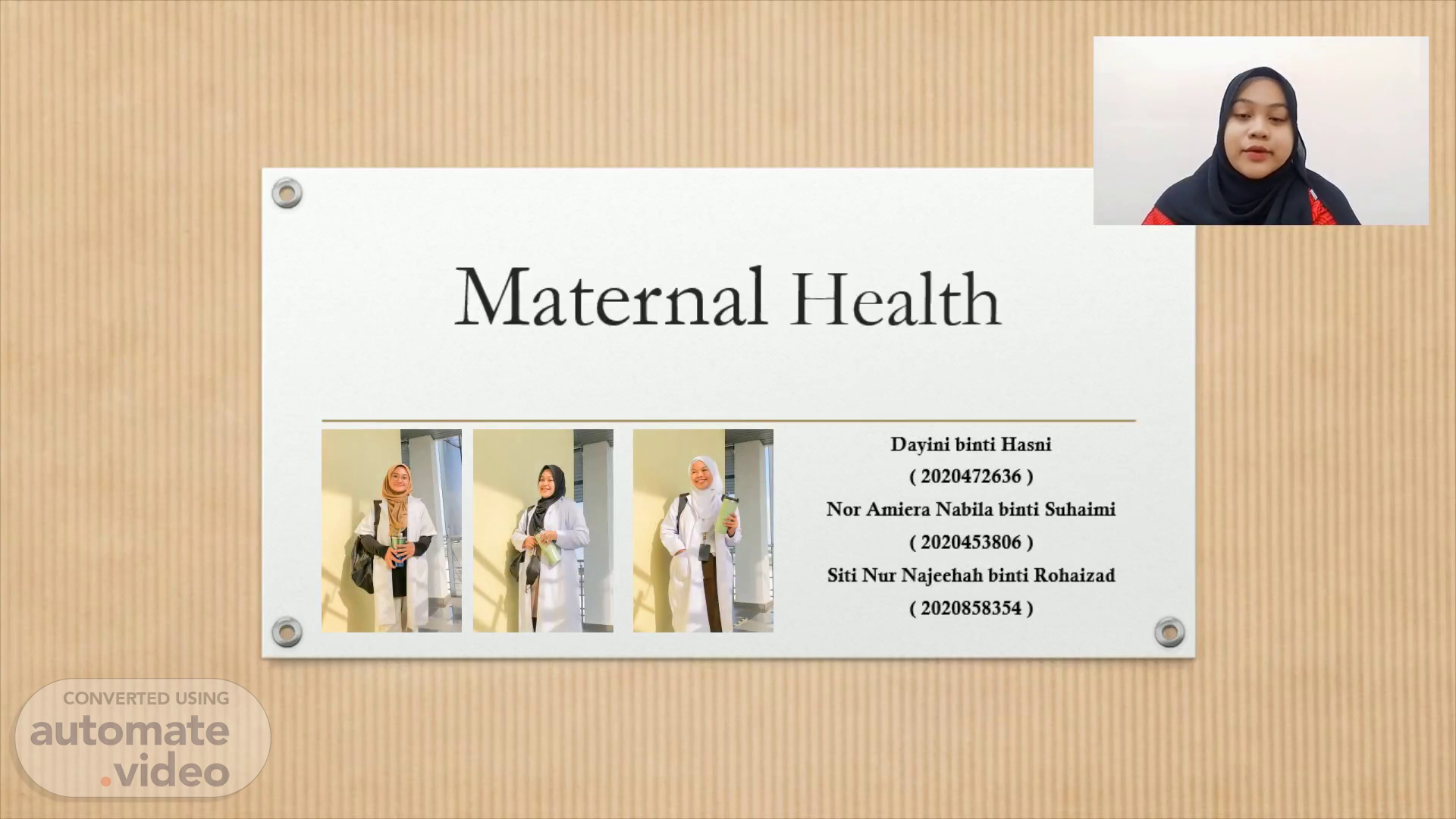Scene 1 (0s)
Maternal Health. Dayini binti Hasni ( 2020472636 ) Nor Amiera Nabila binti Suhaimi ( 2020453806 ) Siti Nur Najeehah binti Rohaizad ( 2020858354 ).
Scene 2 (11s)
Introduction Background of study. Maternal health refers to the health of women during pregnancy, childbirth and the postnatal period. The most common direct causes of maternal injury and death are excessive blood loss, infection, high blood pressure, unsafe abortion, and obstructed labour , as well as indirect causes such as anemia, malaria, and heart disease. Most maternal deaths are preventable with timely management by a skilled health professional working in a supportive environment. Every pregnancy and birth is unique. Addressing inequalities that affect health outcomes, especially sexual and reproductive health and rights and gender, is fundamental to ensuring all women have access to respectful and high-quality maternity care..
Scene 3 (2m 2s)
Introduction Objectives of Study. The objectives of this study are as below: To determine the blood glucose increase while in pregnancy (quantitative) and discover the baby’s gender (qualitative) To determine the age of the mother (quantitative) and discover the baby’s gender (qualitative).
Scene 4 (2m 18s)
Introduction Significance of Study. How true it is that a healthy child needs a healthy Mom. A child cannot be healthy or happy absent the presence of a healthy and happy mother. Prenatal and postpartum maternal health is critical to a mother’s physical and mental well-being and contributes to her ability to render loving, proper care to her newborn child at birth and years thereafter. Most pregnant women give their focus to the development and health of their unborn child. However, it is important for expecting mothers to have regular prenatal visits not only to ensure the health of their child, but their own health as well both during and after pregnancy..
Scene 5 (3m 36s)
Methodology Data description. This assignment was study for us to analyze the relationship between the blood glucose increase while in pregnancy (quantitative) and the baby’s gender (qualitative). This study was participated by 100 people with different health, age and weight. The range of the age for the participant was from 22 - 43 years old, which can be considered from early adulthood to middle range age. In this study, baby’s gender is the qualitative variables. Meanwhile, the blood glucose level while in pregnancy are the quantitative variables..
Scene 6 (4m 37s)
Methodology Graphical Description. Firstly, a bar chart will be constructed based on the table of distribution of volunteers according to their child’s baby gender. Secondly, a table will be tabulated based on the age of the volunteers and the number of volunteers. From the data tabulated, an ogive will constructed according to the distribution of the age and the number of volunteers. Thirdly, a table with data of blood glucose level while in pregnancy of the volunteers and the numbers of the volunteers are tabulated. Based on the data, a histogram will be constructed according to the distribution of the blood glucose level while in pregnancy and the number of volunteers on x-axis and y- axis respectively..
Scene 7 (5m 52s)
Methodology Numerical Technique. Based on this study, we have included the value of mean, median, mode, variance, standard deviation, skewness, range, minimum, maximum, first quartile and third quartile. The relationship between the age of the mother against the blood glucose level while in pregnancy is also represented by correlation and regression analysis. Correlation analysis is used to measure the strength of these two variables. The value of correlation coefficient for the data obtained in the study of the age and the blood glucose level is determine whether it has strong or weak positive or negative correlation. The dependent variable (baby’s gender) is the variable in regression that cannot be controlled or manipulated..
Scene 8 (7m 14s)
Results and Interpretation Data representation. Based on the data that we have obtain, we already identified the qualitative and quantitative variable based on their characteristic. We can pin point that the quantitative data includes the the variable of the age of the mother and the blood glucose level while in pregnancy. While the variable baby’s gender is classified as the qualitative data..
Scene 9 (7m 49s)
Results and Interpretation Data representation Bar Chart : Baby’s Gender.
Scene 10 (8m 58s)
Results and Interpretation Data representation Pie Chart : Smoke.
Scene 11 (11m 52s)
Results and Interpretation Data representation Histogram & Frequency Polygon : The Monitor of Blood Glucose.
Scene 12 (13m 35s)
Results and Interpretation Data representation Age of Mother.
Scene 13 (14m 49s)
Results and Interpretation Descriptive Statistics Analysis.
Scene 14 (15m 7s)
Results and Interpretation Descriptive Statistics Analysis The Blood Glucose level while in pregnancy.
Scene 15 (15m 36s)
Results and Interpretation Descriptive Statistics Analysis The Age of the Mother.
Scene 16 (16m 6s)
Results and Interpretation Correlation and Regression.
Scene 17 (16m 50s)
Conclusion. Based on data that we have interpret, we can conclude that the increasing in the blood glucose of the volunteers will causes the bad impact of the volunteers. We can also conclude that the number of volunteers at 100 people. On average, the age of volunteers are 31 years old and the average for blood glucose level while in pregnancy was 96.81 mg/dL. The oldest in the age of the mother that were collected was 44 years old and the highest blood glucose level while in pregnancy was 139 mg/dL . based on standard deviation, we can also conclude that the data for the variable the age of mother in years old will deviate much more and spread much further from the mean than the data for the variable running speed of volunteers in years old..
Scene 18 (17m 47s)
Thank You <3.
